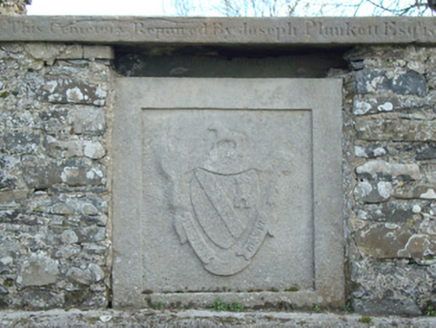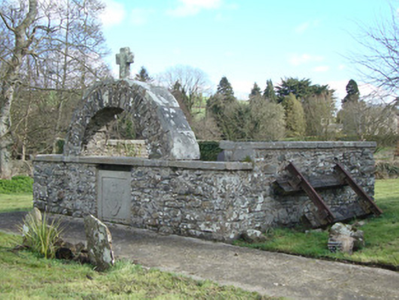Survey Data
Reg No
41309008
Rating
Regional
Categories of Special Interest
Architectural, Historical
Original Use
Monument
In Use As
Monument
Date
1720 - 1820
Coordinates
293263, 306998
Date Recorded
03/04/2013
Date Updated
--/--/--
Description
Freestanding rectangular-plan grave monument, erected 1730 and repaired c.1800, bearing dedication to Joseph Plunkett. Rubble limestone walls with granite coping, stepping lower at west elevation. Rock-faced limestone round arch to west elevation, dressed with granite coping, having regular holes along extrados of arch. Carved stone cross to apex of arch bearing illegible inscription. Carved granite coat of arms to centre of west elevation, having Plunkett family insignia of horse over shield with tower in top right, flanked by inscribed ribbon motif. Stone lintel over carved shield bearing inscription 'This Cemetery Repaired By Joseph Plunkett Esq. [18??]'. Concealed recessed lintel between inscribed coping and shield bearing inscription '… Plunkett his Chapell 1730'. Three headstones to interior, leaning against east wall. Modern concrete path to west elevation leading from church to south.
Appraisal
This masonry structure is located in an ancient graveyard to the south of the river in Inishkeen, in an early monastic site of the sixth or seventh century containing the remains of a round tower, and a mid-nineteenth-century Church of Ireland church. The monument was in all probability designed to resemble the ruins of a medieval Irish chapel as it resembles the latter in both scale and plan form. The Plunkett family were important local landlords in the north Louth and south Monaghan area, residing at Tallanstown at Louth Hall (now derelict) as Lords Louth. A survey from the 1830s shows that Lord Louth owned 371 acres in Lacklum and Lannatt townlands, both in the parish of Inishkeen. This monument embodies a connection between the Plunkett family and the historical development of Inishkeen and may have been contrived as a means of assigning the family a sense of local identity. The regular holes along the arch on the west elevation indicate that the stones may have previously been employed as part of the ruined church on this site. This late seventeenth or early eighteenth-century monument is replicated in the nearby Catholic graveyard, which is also dedicated to members of the Plunkett family.



